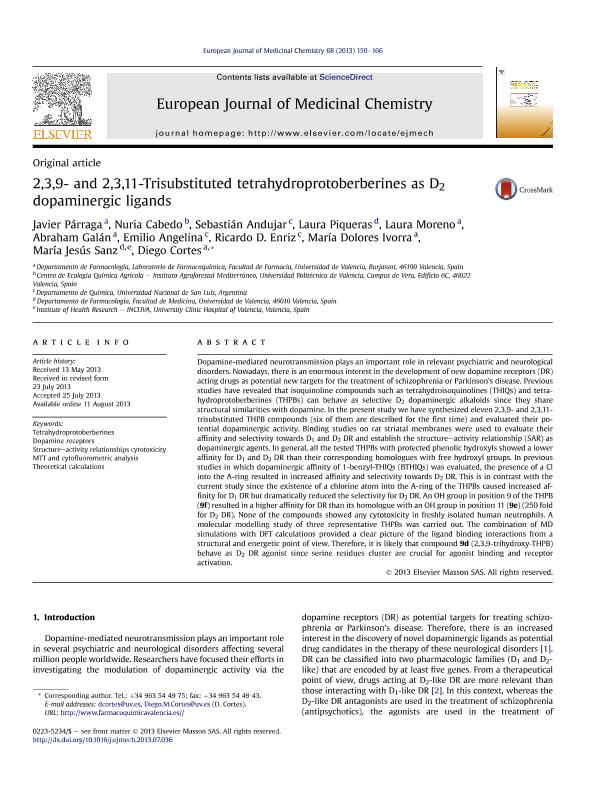Artículo
2,3,9- and 2,3,11-Trisubstituted tetrahydroprotoberberines as D2 dopaminergic ligands
Párraga, Javier; Cabedo, Nuria; Andújar, Sebastián Antonio ; Piqueras, Laura; Moreno, Laura; Galán, Abraham; Angelina, Emilio Luis
; Piqueras, Laura; Moreno, Laura; Galán, Abraham; Angelina, Emilio Luis ; Enriz, Ricardo Daniel
; Enriz, Ricardo Daniel ; Ivorra, María Dolores; Sanz, María Jesús; Cortes, Diego
; Ivorra, María Dolores; Sanz, María Jesús; Cortes, Diego
 ; Piqueras, Laura; Moreno, Laura; Galán, Abraham; Angelina, Emilio Luis
; Piqueras, Laura; Moreno, Laura; Galán, Abraham; Angelina, Emilio Luis ; Enriz, Ricardo Daniel
; Enriz, Ricardo Daniel ; Ivorra, María Dolores; Sanz, María Jesús; Cortes, Diego
; Ivorra, María Dolores; Sanz, María Jesús; Cortes, Diego
Fecha de publicación:
11/08/2013
Editorial:
Elsevier
Revista:
European Journal of Medical Chemistry
ISSN:
0223-5234
Idioma:
Inglés
Tipo de recurso:
Artículo publicado
Clasificación temática:
Resumen
Dopamine-mediated neurotransmission plays an important role in relevant psychiatric and neurological disorders. Nowadays, there is an enormous interest in the development of new dopamine receptors (DR) acting drugs as potential new targets for the treatment of schizophrenia or Parkinson's disease. Previous studies have revealed that isoquinoline compounds such as tetrahydroisoquinolines (THIQs) and tetrahydroprotoberberines (THPBs) can behave as selective D2 dopaminergic alkaloids since they share structural similarities with dopamine. In the present study we have synthesized eleven 2,3,9- and 2,3,11-trisubstituted THPB compounds (six of them are described for the first time) and evaluated their potential dopaminergic activity. Binding studies on rat striatal membranes were used to evaluate their affinity and selectivity towards D1 and D2 DR and establish the structure–activity relationship (SAR) as dopaminergic agents. In general, all the tested THPBs with protected phenolic hydroxyls showed a lower affinity for D1 and D2 DR than their corresponding homologues with free hydroxyl groups. In previous studies in which dopaminergic affinity of 1-benzyl-THIQs (BTHIQs) was evaluated, the presence of a Cl into the A-ring resulted in increased affinity and selectivity towards D2 DR. This is in contrast with the current study since the existence of a chlorine atom into the A-ring of the THPBs caused increased affinity for D1 DR but dramatically reduced the selectivity for D2 DR. An OH group in position 9 of the THPB (9f) resulted in a higher affinity for DR than its homologue with an OH group in position 11 (9e) (250 fold for D2 DR). None of the compounds showed any cytotoxicity in freshly isolated human neutrophils. A molecular modelling study of three representative THPBs was carried out. The combination of MD simulations with DFT calculations provided a clear picture of the ligand binding interactions from a structural and energetic point of view. Therefore, it is likely that compound 9d (2,3,9-trihydroxy-THPB) behave as D2 DR agonist since serine residues cluster are crucial for agonist binding and receptor activation.
Archivos asociados
Licencia
Identificadores
Colecciones
Articulos(CCT - SAN LUIS)
Articulos de CTRO.CIENTIFICO TECNOL.CONICET - SAN LUIS
Articulos de CTRO.CIENTIFICO TECNOL.CONICET - SAN LUIS
Articulos(IMIBIO-SL)
Articulos de INST. MULTIDICIPLINARIO DE INV. BIO. DE SAN LUIS
Articulos de INST. MULTIDICIPLINARIO DE INV. BIO. DE SAN LUIS
Citación
Párraga, Javier; Cabedo, Nuria; Andújar, Sebastián Antonio; Piqueras, Laura; Moreno, Laura; et al.; 2,3,9- and 2,3,11-Trisubstituted tetrahydroprotoberberines as D2 dopaminergic ligands; Elsevier; European Journal of Medical Chemistry; 68; 11-8-2013; 150-166
Compartir
Altmétricas



